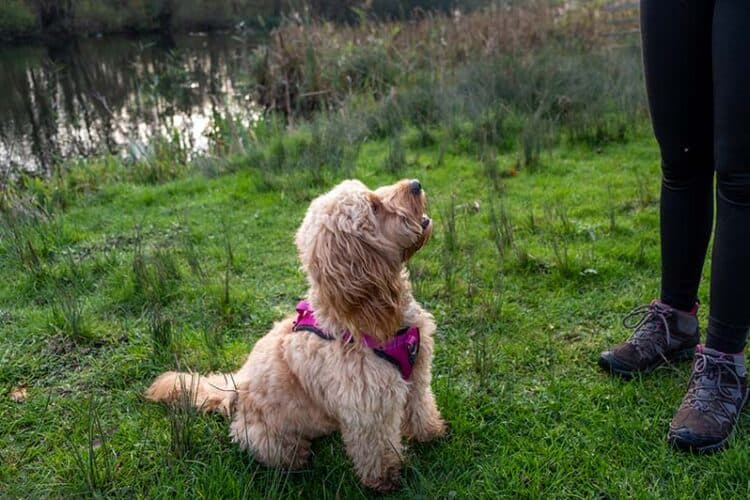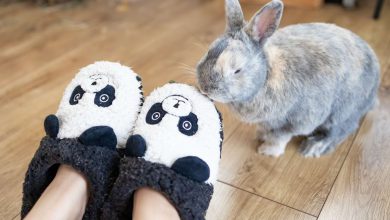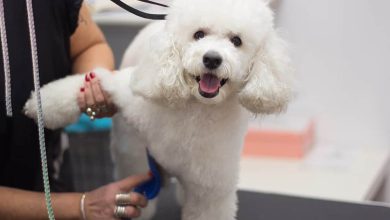8 Tips on How to Train a Cockapoo – Vet Approved Advice

You’ve finally gotten your new Cockapoo, so what will you do next? Train them, of course! Training is one of the most vital things you can do with any dog breed, and the Cockapoo is no different.
But are Cockapoos easy to train? Absolutely! This breed is highly intelligent due to its Poodle heritage, which makes training them a much easier task than many other breeds. But even though these pups are fairly easy to train, that doesn’t mean a few tips wouldn’t be helpful. Read on for eight tips on how to train a Cockapoo that will have you and your dog breezing through the learning process!
Before You Begin
You’ll need a few things before you begin training your dog, and if you’ve already brought your pet home, you likely have these on hand. If not, then make sure you have the following:
- Treats
- A crate
- A leash
- A harness
- Patience
We understand that some pet parents aren’t fans of crate training, so you can skip that part if needed (though it will help with both house training and separation anxiety!). And if you end up having trouble with training, we recommend finding a reputable trainer to lend a hand.

The 8 Tip on How to Train a Cockapoo
Here you’ll find eight tips that will help you immensely while training your pet, no matter what you’re attempting to teach it.
1. Be Patient
We mentioned it above, but it’s true; training a dog takes a lot of patience. Your pup is learning along with you, and sometimes, for every step forward, you’ll take a step back. That’s to be expected, though. And it may take your pet several tries to get a command or trick down, so don’t get frustrated or overwhelmed if it takes a bit of time. Eventually, your Cockapoo will get what you’re teaching it, we promise!
2. Be Consistent
Consistency is vital, no matter what you’re teaching your pup. If you’re aiming to house train your Cockapoo and spend two days taking it out every 30 minutes, only to take it out every 2 hours on the following day, you shouldn’t be surprised if your pet has an accident in the home. It’s come to expect what will happen and when, and by disrupting the routine, you’ve caused a setback. So, remember, consistency is key!
3. Take Your Time
It’s tempting to throw a ton of new things at your pet all at once during training (because you want it to understand the command “sit” and realize it needs to let you know when it wants to go out, etc., from the get-go). Unfortunately, that’s not going to work out well. Not only will too much information at once overload your pup, but if you hold long training sessions, you’ll lose your dog’s interest rather quickly. Instead, take things command by command, step by step, and don’t engage in training sessions longer than 5–10 minutes or so. This is definitely a case where slow and steady wins the race!

4. Use Positive Reinforcement, Not Negative
Never, ever punish or yell at your dog for making a mistake. It won’t serve any useful purpose; it will only make your pet scared of you and could even encourage it to repeat the same behavior again (this time on purpose and when you aren’t around). Instead of punishing your pet, redirect it and praise it for the correct behavior. And when your Cockapoo learns something new or makes progress in its training, utilize positive reinforcement in the form of both treats and praise to encourage it to keep learning!
5. Start Simple with Basic Commands
You wouldn’t expect a child to read or write without having been taught their ABCs, would you? It’s the same for your dog. You’ll want to teach your dog basic commands, such as “sit,” “come,” “lie down,” or “heel,” before you move on to more complicated matters. Once your pup has these basic building blocks down, you can branch out into teaching it more difficult things, like how to walk properly on a lead or be okay while on its own.
6. Socialize Your Cockapoo Early
Early socialization is vital for any dog breed. Things that happen in the first few months of your pup’s life become critical factors in how well your pet ends up developing socially. A lack of introduction to other dogs or pets, people, and even new locations can result in your Cockapoo becoming anxious, fearful, wary of others, and possibly aggressive. But proper socialization will have your dog growing into a confident and sociable animal that’s friendly and unafraid of new people and places.

7. Teach Your Pet How to Be Alone
This is a helpful training tip for any dog breed, but especially for Cockapoos, as they are not fans of being left to their own devices for hours at a time. And that dislike of being on their own can result in lots of barking or even mischievous behavior like chewing up all the shoes they see. That dislike may even grow into full-blown separation anxiety if not nipped in the bud. So, teaching your pet how to be okay while alone is vital for the Cockapoo (and teaching them this isn’t complicated; it may just take some time).
8. Crate Train Your Dog
Again, we know some people don’t like the idea of crates, but when done correctly, crate training teaches your dog that its crate is a safe, happy place. In fact, crates are excellent to use when teaching your dog how to be on its own because they can be used as a safe place. Crate training is also an excellent way to help house-train your dog. The trick to crate training is to never use it as a punishment and to not leave your pet in there for more than a few hours at a time.
Conclusion
Training your Cockapoo can seem like a big undertaking (because it is), but with time and patience and the fact that Cockapoos are relatively easy to train, you should get the job done. And using the eight tips above will help that training go a bit smoother (and maybe even more quickly). The most important tips to remember from this list are to be patient and consistent and to take your time in training.
And if you feel like you’re having a spot of trouble or just don’t have time to go through proper training with your pet, you can easily find a reputable trainer to help you out!
Featured Image Credit: Shutterstock



